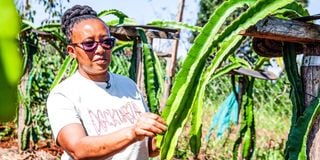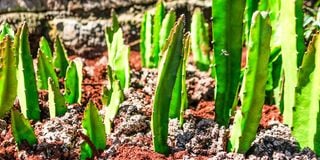After 13 years of toiling on a dragon fruit farm, Moses Muguna embarked on his own journey of cultivating this exotic fruit on a larger scale, delving into a market craving its unique benefits.
It was like letting go of the only bird in hand to explore the wilderness for another.
“It was daunting at first, unsure if it would blossom into a flourishing venture,” reflects Moses, reminiscing on his transition from farmhand to entrepreneur.
He had plotted his exit well in advance, slowly accumulating dragon fruit seedlings during his tenure at his former workplace. Each seedling cost him Sh500.
His initial scepticism morphed into optimism as he plunged wholeheartedly into this endeavour.
On his one-acre farm in Meru County, he has 400 dragon fruits that have drastically changed his fortunes. Gone are the days when he had to break his back to earn some money. Nowadays, with little input, his fruits mint him cash.
In his farm, Moses now finds himself fielding orders with ease from wholesellers and retailers.
Dragon fruit farming is swiftly gaining traction in Kenya, buoyed by a growing appetite for healthier dietary choices and the burgeoning vegan demographic.
Dragon fruit is among a small group of foods considered ‘superfoods’ because of their high nutritional content.
It is rich in vitamins and minerals (beta-carotene, vitamin E, vitamin lycopene, phosphorus and calcium) and essential fatty acids. Moreover, it is rich in antioxidants, fibre and potassium.
“It can protect cells, regulate digestion, lower blood sugar levels, improve heart, eye and skin health and boost energy levels,” sums up Oxfarm, an African agribusiness company that helps fruit farmers produce market-ready produce and improve efficiency.

A developing dragon fruit at Alice Waithera’s farm in Gathiruini Kiambu County on May 13, 2024.
Photo credit: Billy Ogada | Nation Media Group
Alice Waithera is among consumers who have been going into dragon fruit farming in droves.
Captivated by the fruit’s tantalizing sweetness during her business sojourn in China, she returned to Kenya determined to cultivate it locally.
“Discovering its exorbitant price locally, coupled with its myriad nutritional benefits, fueled my resolve to cultivate it,” Alice shares.
Six years into the venture, her quarter-acre farm in Gathiruini, Kiambu County, now teems with 120 dragon fruit trees, serving not only as a source of harvest but also as an educational hub for budding enthusiasts.
She regrets not starting earlier.
“I harvest thrice annually, yielding 10 crates per cycle, all of which are sold locally as I map out plans for expansion,” she beams.

Alice Waithera at her farm in Gathiruini Kiambu county on May 13, 2024.
Photo credit: Billy Ogada | Nation Media Group
Moses asserts that dragon farming promises a lucrative return. “One post yields approximately 30 kilogrammes of dragon fruit. With 400 posts, that’s about 12,000 kilogrammes.”
Dragon fruit, also known as pitaya or strawberry pear, boasts vibrant hues and a distinctive flavour. Mose and Alicespecialise in cultivating the red and white varieties, that have a ready market in Kenya.
Fostering growth
The cultivation of dragon fruit demands meticulous planning and resource allocation, according to agricultural experts. Soil composition, drainage, and pH levels play pivotal roles in ensuring optimal growth and yield.
Cultivation techniques
While dragon fruit can be propagated from seeds or stem cuttings, each method bears its nuances and challenges. Seed propagation offers simplicity but may yield offspring with unpredictable traits. Stem cuttings, though more controlled, necessitate stringent care during initial stages.
Sustainability and yield
Thriving in warm climates with minimal water requirements, dragon fruit plants can yield bountiful harvests for up to three decades, with periodic pruning revitalising fruit production.
Navigating challenges
While the fruit’s resilience minimises susceptibility to pests and diseases, vigilance against environmental adversities remains paramount. Cold spells pose a minor threat, easily mitigated with preventive measures.

Alice Waithera’s Dragon fruit plant nursery pictured on May 13, 2024, in Gathiruini, Kiambu County.
Photo credit: Billy Ogada | Nation Media Group
Seizing opportunities
Despite the nascent status of dragon fruit in the local market, burgeoning demand has propelled its value skyward. Its rich nutritional profile and versatile applications position it as a lucrative commodity for discerning consumers.
Beyond the harvest
Dragon fruit’s versatility extends beyond its harvest, offering avenues for value addition and extended shelf life through processing into various products like juices, jams, and herbal teas.
A fruity future
As demand surges and supply struggles to keep pace, farmers like Moses and Alice find themselves at the epicenter of a burgeoning market, poised to reap the rewards of their labour while nurturing Kenya’s growing affinity for this exotic fruit.
Dragon fruit market
Demand for dragon fruit is growing, but supply remains low. Ms Waithera is among the enthusiastic dragon fruit farmers who plan to tap into the market soon.
But Mr Muguna’s story is different.
“People from all over are consuming the fruit. Many people need the fruit. I don’t even have enough to export. I get orders from supermarkets in the area. I can’t meet the demand of the market outside the district,” he says.









